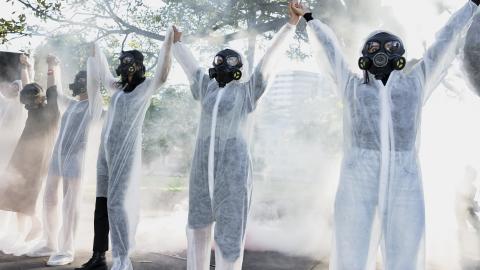Gas Attacks Reveal a War on Iranian Women

Mar 20, 2023
The National Interest
Gas Attacks Reveal a War on Iranian Women
These biological attacks come at a time when Iranian women are challenging the regime more than ever before.


In the past few months, poison attacks have affected hundreds of Iranian schoolgirls, prompting some parents to take their children out of school due to fear of what some have dubbed “biological terrorism.”
These attacks started in November in Qom, which is the heartland of Shiite extremism and home to Iran’s Shiite seminary and Islamic institutions. This wave of toxic gas attacks has expanded to the rest of the country, but with thirty school attacks, the ultraconservative city of Qom still leads the list of the most-targeted cities.
Speculation on the perpetrators of such attacks continues but the regime itself and regime-affiliated extremist groups are the main suspects. Some local media have said that it could be the work of religious zealots who want to prevent girls from attending school. Others, including former Vice President Mohammad Ali Abtahi, have speculated that the poisonings are the work of hardliners who want to “copy” the Taliban in Afghanistan and the militant Islamist group Boko Haram in Nigeria, which have banned women’s education and terrorized parents to stop sending their girls to school. Abtahi has asked in an Instagram post: “Has Boko Haram come to Iran?”
Several regime officials have highlighted the intentional nature of the serial poisoning of female students in Qom and other cities. Iran’s deputy education minister has admitted these attacks are “intentional” and Iran’s attorney general has acknowledged the poisoning of students in the city of Qom might be a “deliberate criminal act.”
Yet, as in all other cases when things go wrong, Iran’s senior officials, including its president, Ebrahim Raisi, have blamed foreign enemies for schoolgirl poisonings.
These reportedly intentional biological attacks come at a critical time: the regime in Iran has been challenged by the death of Mahsa Jina Amini at the hands of Iran’s “morality police” on September 16, 2022, which sparked large protests across the nation. Consequently, it appears that the Iranian regime is taking revenge on this women-led movement by indiscriminately targeting schoolgirls.
A race between Sunni and Shiite extremists on misogyny
Iran remains the leading state sponsor of global terrorism. The Islamic regime brutally represses its own people and supports instability, chaos, and terrorist organizations abroad.
As a predominantly Shiite country, Iran used to have sectarian animosity with such extremist groups like Al Qaeda. However, Iran has occasionally formed an anti-American alliance of convenience with Sunni terrorist organizations, hosting their leaders and providing them with logistical and financial support. The U.S. State Department stated in February that Said al-Adel, an Iran-based Egyptian, has become the head of Al Qaeda following the July 2022 death of Ayman al-Zawahiri. In addition, the former U.S. special representative for the reconciliation in Afghanistan, Zalmay Khalilzad, recently said that Iran has become a new center of Al Qaeda.
In addition to hosting, funding, and arming Sunni extremists, Iran also competes with these groups to make its Shiite version of Islam a more puritan, brutal, and misogynist brand. What Iran is doing with its schoolgirls is reminiscent of acts of such terrorist organizations as the Taliban, ISIS, Boko Haram, and Al Qaeda who oppose women’s education. Iran’s Shiite fanatics are competing with their Sunni rivals while the mullahs in Tehran deeply fear the progressive women’s movement that has adopted the “Woman, Life, Freedom” slogan, three components that go against the founding principles of this clerical regime. Thus, the government is adamant to clamp down and deter the women’s activism in Iran, even by means of poisoning them.
Silencing, stoning, enslaving, and taking revenge on the women is an inalienable part of Islamist extremist entities that despise women just for being women, especially if those women—like brave girls in Iran—dare to seek freedom from clerical tyranny, Islamist misogyny, and inhumane Sharia law.
Putin’s mysterious poison game
Russian president Vladimir Putin has, on several occasions, used mysterious poisons and other biological and toxic substances to get rid of his enemies. He has also used these substances against schoolchildren. When Putin came to power in Russia in 1999, he started punishing the independence-seeking Chechen nation by indiscriminately bombing Chechen civilians, leveling the capital, Grozny, and targeting Chechen schoolgirls by collectively poisoning them by potentially using chemical agents or biological weapons.
When she was seventeen years ago, Anna Politkovskaya, a prominent Russian investigative journalist and human rights activist, started probing the poisoning cases of Chechen schoolgirls and began publishing her findings in 2006. She was found dead in her apartment a couple of months later. No one was charged for the murder as impunity reigns for perpetrators who go after anti-Putin activists.
A similar pattern is repeating itself in Iran as the clerical regime is trying to collectively punish women by means of mass poisoning as there is no will to find and charge the perpetrators. Inspired by Putin’s poison game, Tehran has waged a war against schoolgirls by indiscriminately punishing brave Iranian women for resisting the regime’s efforts to subjugate and indoctrinate them.
Iran, Russia, and China
Iran has shown great interest in importing Russian and Chinese repression technologies, and it is possible that Iran has acquired its poisoning technology from Russia.
Xi Jinping’s China is another source of inspiration for Iran. China is a dystopian, human rights nightmare as collective punishment can go as far as the mass rape and detention of the Uighur people, especially women in Muslim and Turkic-speaking Xinjiang province.
One can’t help but notice that misogyny is a common trait of all repressive regimes. Putin punished, in mass, Chechen women for giving birth to tough fighters who wanted independence from Russian tyranny. Xi is collectively punishing Uighur women for giving birth to a generation that wants to preserve their culture and tradition and defy the Chinese Communist Party’s indoctrination. Iran is indiscriminately punishing women and schoolgirls because of their leading role in anti-regime protests that started with Amini’s brutal death.
Iran, Russia, China, and other authoritarian regimes fear women the most. To deprive their nation of liberty, Putin’s Russia, Xi’s China, and clerical Iran along with Islamist terrorist organizations suppress women’s very existence.
What America can do
While the women in Iran are putting their lives at risk and fighting for their emancipation and dignity, the democratic world led by the United States must take measures to ensure that they are on the side of the freedom-seeking women in Iran, not the regime.
The Biden administration needs an effective and coercive strategy to address Iran’s nuclear and human rights dossiers; it cannot remain indifferent to Iran’s proliferation threat and human rights violations.
Washington must act swiftly as the Iranian regime has enriched uranium to 84 percent purity, becoming closer than ever to weapons-grade material. At the same time, Tehran seeks sophisticated S-400 air defense systems from Russia which would make a potential Israeli airstrike on Iran’s nuclear facilities harder. The United States must take steps to ensure that Tehran will never access nuclear weapons to initiate an atomic Armageddon.
The free world should also be able to concur that the compulsory hijab is against women’s rights. Unlike what the Iranian regime and other radical Islamists say, the compulsory hijab is not part of the culture and national tradition in Iran or elsewhere in the Muslim world. The compulsory veil is a sign of submission and subjugation of women. That is one reason why Iranian women have symbolically been burning their headscarves during protests. To support Iranian women, Western diplomats must stop complying with this discriminatory and myogenic law when traveling to Iran. Recently, the Iranians were outraged by the Swiss ambassador’s decision to wear a long black veil during a visit to a shrine in Qom, the very city most affected by poisonous attacks against girls and women.
For the United States, devising a comprehensive strategy for targeting human rights abusers is indispensable. Designating those Iranian officials who are responsible for the biological war against women and are involved in the poisoning, killing, harming, denigrating, and subjugation of women in Iran should be a priority. The U.S. Department of the Treasury’s Office of Foreign Assets Control can do a better job of further sanctioning and including Iranian individuals and entities that are connected to women’s rights abuse in the Specially Designated Nationals and Blocked Persons list.
Read in the National Interest.
https://www.hudson.org/human-rights/gas-attacks-reveal-war-iranian-women